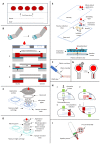Revolutionizing Blood Collection: Innovations, Applications, and the Potential of Microsampling Technologies for Monitoring Metabolites and Lipids
- PMID: 38248849
- PMCID: PMC10818866
- DOI: 10.3390/metabo14010046
Revolutionizing Blood Collection: Innovations, Applications, and the Potential of Microsampling Technologies for Monitoring Metabolites and Lipids
Abstract
Blood serves as the primary global biological matrix for health surveillance, disease diagnosis, and response to drug treatment, holding significant promise for personalized medicine. The diverse array of lipids and metabolites in the blood provides a snapshot of both physiological and pathological processes, with many routinely monitored during conventional wellness checks. The conventional method involves intravenous blood collection, extracting a few milliliters via venipuncture, a technique limited to clinical settings due to its dependence on trained personnel. Microsampling methods have evolved to be less invasive (collecting ≤150 µL of capillary blood), user-friendly (enabling self-collection), and suitable for remote collection in longitudinal studies. Dried blood spot (DBS), a pioneering microsampling technique, dominates clinical and research domains. Recent advancements in device technology address critical limitations of classical DBS, specifically variations in hematocrit and volume. This review presents a comprehensive overview of state-of-the-art microsampling devices, emphasizing their applications and potential for monitoring metabolites and lipids in blood. The scope extends to diverse areas, encompassing population studies, nutritional investigations, drug discovery, sports medicine, and multi-omics research.
Keywords: dried blood spot; drug discovery; lipidomics; metabolomics; microsampling; personalized medicine.
Conflict of interest statement
The authors declare no conflicts of interest.
Figures


Similar articles
-
Pre-analytic assessment of dried blood and dried plasma spots: integration in mass spectrometry-based metabolomics and lipidomics workflow.Anal Bioanal Chem. 2025 Apr;417(9):1791-1805. doi: 10.1007/s00216-025-05760-z. Epub 2025 Feb 5. Anal Bioanal Chem. 2025. PMID: 39907755 Free PMC article.
-
Perforated dried blood spot accurate microsampling: the concept and its applications in toxicokinetic sample collection.J Mass Spectrom. 2012 May;47(5):655-67. doi: 10.1002/jms.3015. J Mass Spectrom. 2012. PMID: 22576879
-
Challenges and opportunities in blood flow through porous substrate: A design and interface perspective of dried blood spot.J Pharm Biomed Anal. 2019 Oct 25;175:112772. doi: 10.1016/j.jpba.2019.07.020. Epub 2019 Jul 21. J Pharm Biomed Anal. 2019. PMID: 31362248 Review.
-
Blood microsampling technologies: Innovations and applications in 2022.Anal Sci Adv. 2023 May 18;4(5-6):154-180. doi: 10.1002/ansa.202300011. eCollection 2023 Jul. Anal Sci Adv. 2023. PMID: 38716066 Free PMC article. Review.
-
Remote HbA1c testing via microsampling: fit for purpose?Clin Chem Lab Med. 2023 Jul 10;62(1):3-17. doi: 10.1515/cclm-2023-0228. Print 2024 Jan 26. Clin Chem Lab Med. 2023. PMID: 37419657 Review.
Cited by
-
LC-MS-Based Global Metabolic Profiles of Alternative Blood Specimens Collected by Microsampling.Metabolites. 2025 Jan 16;15(1):62. doi: 10.3390/metabo15010062. Metabolites. 2025. PMID: 39852404 Free PMC article.
-
Developing and validating a clinlabomics-based machine-learning model for early detection of retinal detachment in patients with high myopia.J Transl Med. 2024 Apr 30;22(1):405. doi: 10.1186/s12967-024-05131-9. J Transl Med. 2024. PMID: 38689321 Free PMC article.
-
Pre-analytic assessment of dried blood and dried plasma spots: integration in mass spectrometry-based metabolomics and lipidomics workflow.Anal Bioanal Chem. 2025 Apr;417(9):1791-1805. doi: 10.1007/s00216-025-05760-z. Epub 2025 Feb 5. Anal Bioanal Chem. 2025. PMID: 39907755 Free PMC article.
-
A Bioinspired and Cost-Effective Device for Minimally Invasive Blood Sampling.Adv Sci (Weinh). 2024 May;11(18):e2308809. doi: 10.1002/advs.202308809. Epub 2024 Mar 7. Adv Sci (Weinh). 2024. PMID: 38450888 Free PMC article.
-
Quantitation of BCAA and BCKA in plasma and patient-centric dried blood microsamples in a clinical setting.Bioanalysis. 2025 Jun;17(11):707-723. doi: 10.1080/17576180.2025.2515008. Epub 2025 Jun 10. Bioanalysis. 2025. PMID: 40495533 Free PMC article.
References
Publication types
LinkOut - more resources
Full Text Sources
Medical

